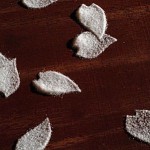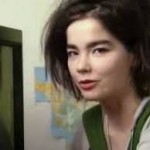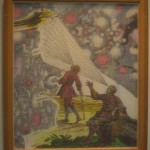The exhibition “New Topographics: Photographs of a Man-Altered Landscape” represented a paradigm shift in the history of photography. Nine then young photographers were selected by curator William Jenkins to show ten prints each at the International Museum of Photography at the George Eastman House (Rochester, New York), from October 1975 until February 1976. Among them, eight were American: Robert Adams, Lewis Baltz, Joe Deal, Frank Gohlke, Nicholas Nixon, John Schott, Stephen Shore, Henry Wessel, Jr., and the ninth was the German couple Bernd and Hilla Becher. The common denominator was “a problem of style:” “stylistic anonymity“, quoting the 1960’s works of Edward Ruscha as possible inspirations for the invited photographers.
The artists were fostered to act as a kind of topographers, avoiding all ambition of romanticism or artistic beauty, in a pursuit for a novel form of objectivity that reminded the parallel research Brian Eno was operating within the musical realm. A radical shift from the traditional depictions of landscape, the common subjects were views of stark industrial landscape, suburban sprawl and urban desolation. No ideal image of nature, but a plain unemotional documentation of the way man has come to alter it.
“The pictures were stripped of any artistic frills and reduced to an essentially topographic state, conveying substantial amounts of visual information but eschewing entirely the aspects of beauty, emotion and opinion,.” “[…] rigorous purity, deadpan humor and a casual disregard for the importance of the images.” (From Wikipedia)
Lewis Baltz (1945 – 2014) was then a very young photographer but soon became a central figure in the “Topographic” movement. Through his investigation on the crisis of technology as a means of human emancipation, the role of the artist and objectivity, Baltz contributed to the aesthetic shift that the exhibition began provoking among a young generation of (mostly) European artists during the late 1970’s
His body of work focused on the search for beauty in bleakness and devastation, a reflection of human control and power through the depiction of common architecture of factories, parking lots, offices. (Ronde de Nuit, Docile Bodies, and Politics of Bacteria). The relationship between inhabitation, anonymity and settlement was explored in books such as The New Industrial Parks near Irvine, California (1974). After moving to Europe, Baltz abandoned his signature -almost shadowless- black and white to explore the medium of large colored prints but kept analysing the relationship between human labor and architecture. In Sites of Technology (1989–92), he depicted the clinical ambiences of modern technological and government research centers in France and Japan.
MR. WITKOVSKY: Very interestingly, though, in the Prototypes at least, you eliminate the human figure. And you create compositions that are very nearly flat, which is – or at least that’s what it seems to be. Not all of them. There are a couple of interiors; there’s a poolside shot; there are other things. But the work that really stands out, if I may argue that, is of walls, and it’s of piping on walls, and it’s of parking lots where you can’t really tell if the parking lot is more than three feet deep, although you assume that to get a car in there – so tell me about this.
MR. BALTZ: Okay, that’s at least two really good questions. Let me see if I can evade both of them. I don’t know when I had this little epiphany, but if you have a human subject, the person is in the picture. Right? And an uninhabited picture has the possibility of the viewer projecting him or herself into the picture. That interested me. The pictures are full of – and they’re all about, you know, manmade – or can we say that now – personmade environments. There’s no purely natural environment in any of my photographs. In fact, in most of them the only natural element may be the sky, and it’s not wholly natural these days either.
My work is full of people – the traces of people – but they’re present in their absence – and maybe this is something I got from Wright Morris’s The Inhabitants. There’s an implied human presence in all my work.
The second question was – I know if you’d asked me that question at the time, I would have given you this sort of hyper-literal, smart-ass, Frank Stella answer – photographs are flat. (…) Actually, they’re virtually flat. It seemed to me that photography was pretty good and even somewhat successful in describing very shallow space. So then my photographs really aren’t flat; they’re more like the space of a bas-relief. (…) And usually there is a plane that echoes the picture plane.
(Excerpt from: Interview with Lewis Baltz conducted by Matt Witkovsky – transcribed online at the Archives of American Art)
The following selection of photos is courtesy of the George Eastman House archive.
Further reading:
New Topographics at the PhotoBook
New Topographic book review at The Online Photographer
Sean O’Hagan’s “New Topographics: photographs that find beauty in the banal“, an article on the Guardian
New Topographics (Redux), at NPR
New Topographics at Artsy
A very recommended 50+ pages interview with Lewis Baltz conducted by Matt Witkovsky – transcribed online at the Archives of American Art
Lewis Baltz biography at the European Graduate School
Lewis Baltz archive at the George Eastman House
Lewis Baltz: Common Objects at Le Bal in Paris (a 2014 exhibition focusing on the relationships between the work of Baltz and that of cinema directors such as A.Hitchcock, M.Antonioni and J-L.Godard)
Lewis Baltz at the Tate
Via: All terrain






I saw Baltz speak at the San Francisco art institute in about 1980… Showed his slides in about 15 minutes then announced time for a break …if anyone has questions come back after a 15-minute break… I was one of the 20 out of 100 we came back after the 15-minute break….. I had been experiencing all this work as poetic, full of metaphor ,and visual acuity…Baltz dis avowed all of this….I left the lecture shaking my head…..having first seen an artist who didn’t know the depth of his own work.